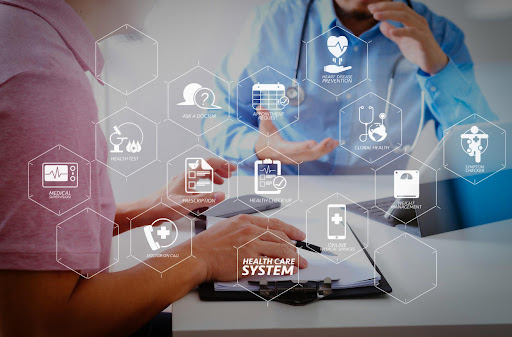
What Is the Most Modern Public Hospital and Why?
А “smart hospital” has become a buzzword in modern medicine but few people understand what this concept truly entails: a single IT environment that is composed of specialized and auxiliary processes that are automated through cloud computing services, AI, and machine learning methods.
Sounds simple enough on paper but the automation of healthcare is no easy task. Countries, as well as local municipalities, spend a lot of money every year trying to establish functional smart hospitals. Whether this money is well-spent is determined by several factors, from achieving e-health benefits to overcoming various challenges set before a smart hospital system.


What are the core principles of e-health?
Estimates show that by 2026, the global smart hospital market will be worth $111.2 billion. An impressive figure that makes people want to learn more about the concept of e-health. Essentially, this term denotes the usage of information technology to support healthcare.
A smart hospital is structured in such a way that it improves efficiency, expands the patient’s capabilities, enhances ethical standards, and ideally, makes healthcare accessible for everyone. It achieves this through attention to the storage and exchange of personal data, improving the patient-hospital relationship, and the general expansion of the healthcare network.

Which segments will smart hospital software improve
As the world is going digital, modern hospitals won’t be able to avoid the trend. Smart hospital software’s main role will be to facilitate patient-hospital interaction in hospital rooms, as well as on an outpatient basis.
Here is a breakdown of what a fully functional smart hospital will improve and some examples of medical facilities that have already embraced the future.
Improved navigation in and around the hospital
Once hooked up to the IoT, mobile technology will be helpful to physically navigate large hospitals. Patients, and more importantly, visitors will receive messages and real-time direction on how to navigate medical facilities, improving the overall workflow.
The Hospitals of Providence in El Paso, Texas boast a Wayfinder that helps patients and visitors navigate their way around their campus. The interactive map provides a step-by-step guide that helps people locate different clinics and labs, as well as suggestions on where to park for better access.

The introduction of smart hospital rooms
Another feature aimed at patients and their families is the introduction of a smart hospital room that will feature touchscreen monitors and/or tablets. Not only will patient-doctor communication improve significantly but treatment will become inclusive, as (non-confidential) patient data becomes easily accessible.
In 2019, a non-profitable hospital in Los Angeles, Cedars-Sinai, introduced a pilot program in more than 100 of their patient rooms that involved hands-free communication. An Alexa-powered platform called Aiva is a voice assistant that allows patients to play music and contact nurses without ever getting up.
Lowering patient no-show rates
For a healthy person, a push notification on their smartphone is more of a nuisance than a benefit. However, push notifications as part of a healthcare software solution can help both patients and hospitals save money and time; not to mention saving lives.
Lowell General Hospital, located northwest of Boston, Massachusetts, introduced ADT (admit, discharge, transfer) real-time notifications to their patients’ primary care physicians. The system was envisioned in a way that the physician can provide feedback in the form of a “latest progress note” that is then attached to the patient’s chart in the hospital.
Enhanced patient-doctor communication
Speaking of communication, one of the biggest concerns patients have with modern technologies is the fact that doctors spend more time imputing data than actually talking to them. A smart public hospital would do away with this, as tête-à-tête communication would take precedence.
Studies have shown that doctors waste a third of their precious patient interaction time looking at a computer screen. Doctor Lloyd Minor, the dean of Stanford University School of Medicine has noticed this and is now advocating for improved electronic health records that would require way less time to fill out.
Tracking biometric data
An Apple Watch might be a fad but in medicine, specialized wearables and smartphones can be used to collect vast amounts of biometric data. Statistics on heart rates and patients’ sugar levels can further be used to improve patient care and accelerate scientific research. Moreover, smart wearables enable doctors to expand the scope of home healthcare, relieving the pressure on hospital capacity.
On the national level, Estonia made the biggest progress in this area, as all of its medical institutions are obliged by law to implement the national electronic health records system. Such a centralized register of medical data opens new avenues for medical research and studies that don’t cause discomfort to patients.

Improved inventory tracking
Finally, hospitals and care centers can use IoT to track their assets and replenish stocks. A smart hospital application can automatically (re)order missing items, without the need for employees to track items manually.
CentraCare is one of the larger healthcare systems in the American Upper Midwest and they have launched a new ERP that included RFID Smart, enabling them to make their supply chain more efficient. As a healthcare provider, their inventory requirements encompass warehouses, carts, supply closes, and storerooms, which would be impossible to manage without a lifesaving QR code on them.
What challenges does the future hold?
Healthcare managers and officials know very well that a smart (public) hospital cannot be built in a day but that it is rather a process that requires time. Like every gradual upgrade, building a smart hospital doesn’t come without a set of challenges that are, luckily, not insurmountable.
Firstly, healthcare organizations have to set their priorities straight and balance between providing high-quality healthcare and ensuring long-term financial productivity, to name just one potential conflict of interest.
Secondly, both medical and non-medical staff have to undergo training on how to use smart management systems. This is one of the main reasons why “becoming smart” should be performed in steps, i.e. phases, rather than taking a giant tech leap that human resources cannot keep up with. If Philips is to be trusted, then the final step in this transformation would be a “hospital without walls!”
Conclusion
At the turn of the 21st century, patient wearables, smart TVs and tablets in hospital rooms, and electronic records were the stuff of science fiction. In under a quarter of a century, these advanced features are becoming the new norm, as the modern public smart hospital is becoming a reality across continents.



